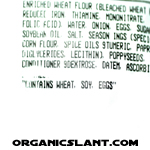 (Organic Slant) What triggered a whole market based around ‘gluten-free’? It’s not just some new food fad; gluten is actually making people of all kinds sick and slowly killing others.
(Organic Slant) What triggered a whole market based around ‘gluten-free’? It’s not just some new food fad; gluten is actually making people of all kinds sick and slowly killing others.
Wheat, a major source of gluten, also happens to be the the number two food subsidized by our government; it’s grown all over the place and put into a large majority of our foods. Studies have shown that back in the 1950s, one in around 5,000 people might have a severe and potentially deadly allergy to gluten known as Celiac’s Disease; now it’s more like a staggering one in 133.
In short, in 60 years, here’s what Celiac Disease figures look like by the decade in America:
1950s: 1 in 5,000
2010s: 1 in 133
Population increase alone cannot come close to accounting for such a vast difference.
Many more people who do not have full-blown Celiac’s may suffer from harmful gluten intolerance issues as well; estimates show as many as 18 million Americans suffer from gluten-derived health issues.
People who get sick eating gluten do so because the protein triggers an auto-immune response that causes the body to attack it’s own intestinal lining. When that happens, any one or more of 200-300 different symptoms can occur, as the body stops being able to absorb its nutrients properly. This can end in so many diseases…and, ultimately, death.
Because the symptoms of gluten intolerance are so varied (and numerous), many people don’t even realize they are suffering from gluten sensitivity issues.
There are 200-300 symptoms of gluten intolerance, so this is just a few of them:
Gastrointestinal symptoms: These are some of the “classic” — although not the most common — symptoms:
- Abdominal pain and distension
- Acid reflux
- Bloating
- Constipation
- Diarrhea
- Gas and flatulence
- Greasy, foul-smelling, floating stools
- Nausea
- Vomiting
- Weight loss or weight gain
Nongastrointestinal symptoms: Interestingly, although gluten sensitivity and celiac disease affect the gut, most people’s symptoms are not gastrointestinal in nature.
- Fatigue and weakness (due to iron-deficiency anemia)
- Vitamin and/or mineral deficiencies
- Headaches (including migraines)
- Joint/bone pain
- Depression, irritability, listlessness, and mood disorders
- “Fuzzy brain” or an inability to concentrate
- Infertility
- Abnormal menstrual cycles
- Dental enamel deficiencies and irregularities
- Seizures
- Clumsiness (ataxia)
- Nerve damage (peripheral neuropathy)
- Respiratory problems
- Canker sores (apthus ulcers)
- Lactose intolerance
- Eczema/psoriasis
- Rosacea (a skin disorder)
- Acne
- Hashimoto’s disease, Sjögren’s syndrome, lupus erythematosus, and other autoimmune disorders
- Early onset osteoporosis
- Hair loss (alopecia)
- Bruising easily
- Low blood sugar (hypoglycemia)
- Muscle cramping
- Nosebleeds
- Swelling and inflammation
- Night blindness
What has happened to our food that so many people who eat it are getting sick enough that large numbers of us require whole entire stores dedicated entirely to removing an ingredient that just so happens to be found in the majority of foods in our country…?
The clip below includes an excerpt from a 1960 U.S. Department of Agriculture short film “Miracles from Agriculture” which might shed a clue on how gluten first started to become such a huge health problem for so many people.
 Connection between household chemicals and gut microbiome
Connection between household chemicals and gut microbiome Apple cider vinegar is good for alot of ailments and a whole lot more
Apple cider vinegar is good for alot of ailments and a whole lot more Science Confirms You Should Stop And Smell The Roses
Science Confirms You Should Stop And Smell The Roses